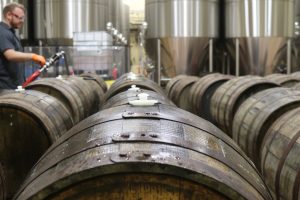The Discovery Channel’s documentary “How Beer Saved the World” (check Netflix) traces the important role that beer has played throughout history -- from the origins of beer at the dawn of history, to special beer developed specifically for space missions. It’s a fun flick and in it the filmmakers present a fairly reasonable case for how important beer is to human history. In fact, they claim, it literally saved the world. In some ways, beer has (and is) saving cities right here in North Carolina.
A Look Back
It wasn’t long ago that many of NC’s now big cities -- Asheville and Charlotte among them -- were mere ghost towns, with downtowns marked more by boarded up windows and abandoned buildings than trendy shops and brew pubs. Then something shifted. Major revitalization efforts began in downtowns across the state and were boosted by the birth of craft breweries. Highland Brewing, the first brewery in Asheville since Prohibition, was the first to open its doors, setting off a string of other brewery openings at record pace. In 1991, Red Oak Brewery (then Spring Garden Brewing) opened in Greensboro. Olde Hickory Brewing opened in Hickory in 1994. 1995 ushered in Carolina Brewing Co. in Holly Springs, Carolina Brewery in Chapel Hill, and Front Street Brewery in Wilmington. Top of the Hill Restaurant and Brewery in Chapel Hill and Huske Hardware House opened in Fayetteville in 1996, and then the next year Green Man Brewing got its start in Asheville’s Jack of the Wood. Asheville Brewing followed in 1998 (originally Two Moons Brew ’n’ View). This is by no means an exhaustive list. You get the point though.
The Pop the Cap Movement
The early 2000s were relatively quiet for beer makers in the Tar Heel State. They had their breweries but could not yet compete in the artisan beer markets exploding in other states. A grassroots movement called Pop the Cap helped to raise the alcohol limit on beers made in NC from 6% to 15%. In August 2005, Gov. Mike Easley signed House Bill 392 into law. Bottle shops across the state responded almost immediately by stocking high-gravity beers, and brewers didn’t waste any time crafting heftier brews. A new world opened for NC brewers.
NC Brewing Today
What has happened to beer making in NC in the past ten years since HB 392 was passed is nothing short of astonishing. According to the North Carolina Craft Brewers Guild, North Carolina now boasts more than 130 craft breweries, more than any other state in the South. Nearly 3,000 jobs have been created inside breweries alone. Add in servers, truck drivers, bottle shop owners and cashiers, hop and barley growers, etc. and that number grows exponentially. Beer has been a good, good thing for North Carolina.
Helping brewers is the “new face” of North Carolina. The craft beer demographic is 25 to 55 years old, is college educated, and has a family income of at least $80,000. There are a wide variety of universities in North Carolina that produce graduates who meet this demographic and stay local. Transplants from other states also fit that picture. In addition, distribution laws in NC are favorable production. Small brewers, those who make 25,000 barrels or less per year (a barrel is 31 gallons), are able to distribute their beers directly to retailers, saving them the expense of sharing profits with a wholesaler. Georgia and South Carolina, two states that upped their alcohol caps but did not relax their distribution laws, lag seriously behind NC in terms of beer production. Top all these favorable economic conditions off with a hefty dose of pretty NC scenery that’s ripe for tourism, and you have the perfect storm for a booming craft industry.
Issues for Brewers
It’s safe to say craft brewing isn’t going anywhere soon in NC, but continued growth for existing breweries will require excise tax reform and further lifting of distribution limits. High excise taxes, taxes built into the price of goods, mean brewers get taxed at both the federal and state levels. Lower taxes for brewers would mean more capital for equipment (increased production) and marketing (increased sales). Further lifting of distribution limits would also allow brewers to increase production without having to enlist the expensive services of a wholesaler.
Given the fervor for beer in this state and its ability to transform towns, I have no doubt we’ll continue to see favorable economic changes for the industry. If beer is your business, make sure you have the right team in place help you manage your growth.





